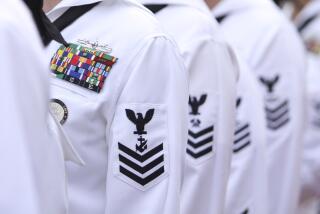Military Used Deadly Gas in 1967 Tests
- Share via
WASHINGTON — The U.S. military in 1967 conducted tests using the deadly sarin nerve agent in a Hawaiian rain forest as part of a Cold War series of chemical and biological experiments on land and sea, the Pentagon said Thursday.
Military units involved in the Hawaii test, dubbed “Red Oak, Phase 1,” were not identified, and there was no indication of harm to troops or civilians from explosions to determine the effectiveness of artillery shells using sarin in the jungle.
But the Defense Department, releasing five new reports on tests conducted in the 1960s and ‘70s, urged any troops involved who might have suffered ill effects to contact the Pentagon.
The Red Oak tests in April and May 1967 were conducted in both the Upper Waiakea Forest Reserve on Hawaii and near Fort Sherman in the Panama Canal Zone. The Panama phase used only a simulated nerve agent, not sarin.
Sarin is a volatile, deadly nerve agent that can be inhaled or absorbed through the eyes and skin. A sufficient dose will, within minutes, cause difficult breathing, a runny nose, confusion and dimming vision, then coma and death. Very little information is available on the long-term effects of low-level exposure to sarin.
The Pentagon on Thursday also released details on four other tests -- three in the Panama Canal Zone and a fourth in an unspecified jungle environment -- but said none used deadly chemical or biological agents.
In addition to the riot-control agent tear gas, however, some of the tests used normally occurring bacteria that more recent information has indicated can cause acute infections.
More than 5,500 members of the U.S. armed forces were involved, including 5,000 who took part in ship-board experiments in the Pacific.
More than 50 veterans have filed claims related to symptoms they associate with exposure to the tests, according to the Department of Veterans Affairs.
More to Read
Sign up for Essential California
The most important California stories and recommendations in your inbox every morning.
You may occasionally receive promotional content from the Los Angeles Times.










